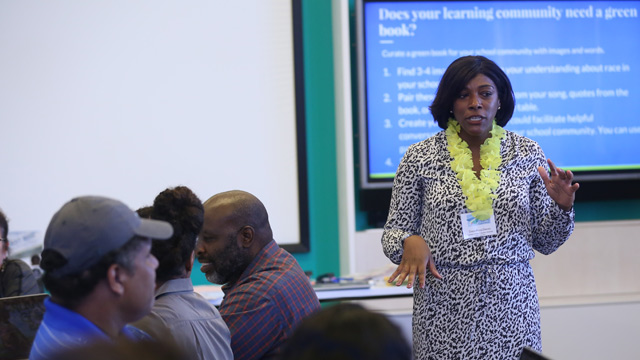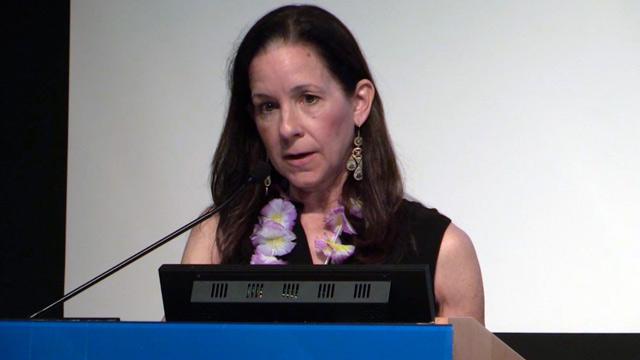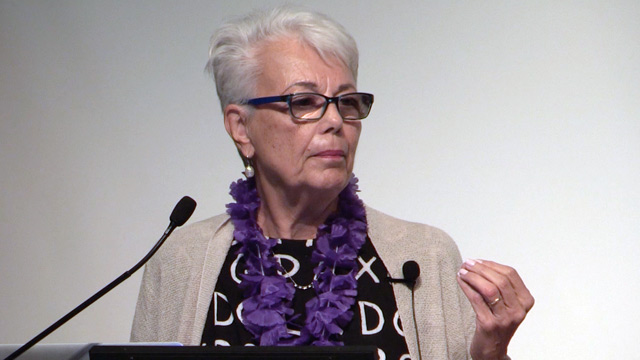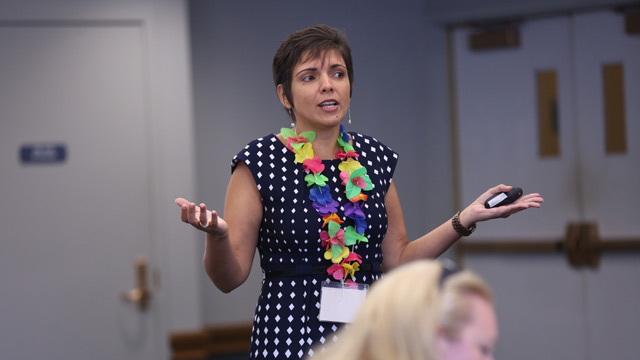Teaching for the New Majority: A TC institute reimagines education for racially diverse classrooms

In the middle of the 20thcentury, thousands of racially segregated public schools in the United States were desegregated, as black and Hispanic students gained access to better-resourced schools that had been all-white. While this civil rights victory helped to close the racial achievement gap, these gains too often came at a cost to students of color, whose history, culture and experiences were ignored or discounted.
During this era of desegregation, two-thirds of black students in public schools were in classrooms taught by white teachers because nearly 44,000 black teachers were fired. Most of these white teachers had limited knowledge of black history and little to no experience with black students, families and communities. Furthermore, they were often told by school district officials not to talk about race in their classrooms for fear it would exacerbate racial tensions in the schools.
“In losing black teachers, black children lost advocates, champions and teachers who set high academic standards for their students and cared deeply about their success,” Amy Stuart Wells, Professor of Sociology & Education, told a racially and ethnically diverse group of educators who gathered in Teachers College’s Cowin Conference Center in mid-July.
To explore the history and issues surrounding racial and ethnic diversity in public schools and foster the educational benefits that can be derived from this diversity, Wells and six of her TC faculty colleagues organized July’s gathering, a first-ever professional training institute for educators called “Reimagining Education: Teaching and Learning in Racially Diverse Schools.”

“In losing black teachers, black children lost advocates, champions and teachers who set high academic standards for their students and cared deeply about their success.”
—Amy Stuart Wells, Professor of Sociology & Education
The 150 participants came from around the country to talk about their experiences with race and to explore curricula and teaching methods aimed at better serving an increasingly diverse student population whose frames of reference and home languages and cultures span the globe.
Wells and TC doctoral students Lauren Fox, Diana Cordova-Cobo and Juontel White opened the institute with a short presentation that went over the legal, demographic and cultural developments surrounding desegregation.

“By the 1970s, we started to see challenges to the common wisdom about children of color as ‘culturally deprived.”
—Sonia Nieto, Professor Emerita of Language, Literacy & Culture. School of Education, University of Massachusetts Amherst
They pointed out that today, as a result of legal challenges that have slowed or reversed school desegregation efforts, public schools have been largely re-segregated. Meanwhile, waves of immigration have created, for the first time, a majority-nonwhite but highly diverse student population in the nation’s public schools. Yet studies show that whites still make up as much as 80 percent of the teaching force, creating even more urgency to ensure that all teachers have the skills to connect with students from all over the world.
“This is a new era,” Wells said. “There are new reasons to address issues of segregation and inequity, and when we do it, we need to remember the history and think about new domains of inequality moving forward.” (Read a story on Wells’ discussion of what black students lost when they moved to majority-white classrooms.)
“Reimagining Education” featured 13 presentations by experts on multicultural education, including student rap artists who teach science and social studies through their music and a ballet performance by students from immigrant families. The four-day institute also included more than 30 workshops on a range of topics, from instruction in diverse classrooms aimed at both closing achievement gaps and assuring all students succeed, to effective leadership in racially diverse schools and districts, student assignment and reassignment policies, to parent engagement and constituency building for diversity.
Teaching as “an act of love”
The common thread was that diversity is an asset – not a negative to be avoided – in the classrooms of today.
“By the 1970s, we started to see challenges to the common wisdom about children of color as 'culturally deprived',” said keynote speaker Sonia Nieto, Professor Emerita of Language, Literacy & Culture at the School of Education, University of Massachusetts Amherst, who traced the history of black education in the United States.
The task now, said Nieto, is to develop not just multicultural education but culturally responsive pedagogy that addresses “attitudes, behaviors and dispositions” and the institutional racism that sustains them. “There is no template, there are no best practices” that can change people’s attitudes, she said. “Teaching is an act of love.”

“There are different kinds of literacies in different households, and we fail kids when we don’t recognize those differences.”
—Mariana Souto-Manning, Associate Professor of Early Childhood Education
The remainder of the institute was devoted to helping teachers recapture for their students of color and other minorities the positive things that black teachers did for black students in the years before desegregation. Among the many small workshops, led by TC professors and students (click here for the full listing of the plenary sessions in Cowin Conference Center) were:
“Reading, Writing, and Talk: Inclusive Teaching Strategies for Diverse Learners,” in which Mariana Souto-Manning, Associate Professor of Early Childhood Education, challenged participants with a classroom literacy exercise that illustrated the difficulties children have when their “home language is not aligned” with their school’s. “There are different kinds of literacies in different households, and we fail kids when we don’t recognize those differences,” said Souto-Manning.
“Developing Racial Literacy with Children’s Literature.” In this session led by Detra Price-Dennis, Assistant Professor of Elementary & Inclusive Education, teachers read the award-winning children’s book Ruth and the Green Book, about an African-American family during the 1950s that takes a car trip from Chicago to Alabama in order to visit relatives. Encountering racism along the way, they use The Negro Motorist Green Book, a Jim Crow-era travel guide that listed lodgings and other businesses that were friendly to black customers. Price-Dennis asked the teachers to create and share green books about their own school communities – not necessarily to help students avoid overt racist threats, but instead to spotlight issues, behavioral codes and other aspects of life with a racial or ethnic focus or impact.
“Deconstructing Racial Microaggressions.” In Counseling Psychology doctoral student Mariel Buque’s session on microaggressions, a lesson on the cumulative negative impact of these often unintended slights against minority groups turned into a real-life, highly teachable moment. A white teacher in the group worried aloud that her black high school students were penalizing themselves in job interviews and other high-stakes situations with adults by failing to “code switch” from adolescent slang to more formal English.
“Am I microaggressing by thinking that way?” she asked.
A black teacher sitting nearby said, carefully, that she thought she was. “Listen to how you’re using the word ‘they’ and how you’re making decisions about how ‘they’ should talk,” she said.
Buque agreed, but offered both speakers some reassuring words. “I commend you for being brave enough to ask,” she told the first teacher. And to the second, she added: “And what you said took courage, too. People who experience microaggressions are in the unenviable position of having to decide between staying silent or saying something. You spoke up.”

"You cannot 'save' a person of color if you cannot see them.”
—Christopher Emdin, Associate Professor of Science & Education
“Hip Hop as Therapy.” In this session, Ian Levy, a Ph.D. student in Counseling Psychology, demonstrated the hip-hop and rap workshops he uses to give his Bronx high school students a way to express their emotions and find solutions to their struggles. Three years ago, Levy said, he created a space with a microphone in the corner, where kids could come after school or during lunch and just talk and experiment with recording. That effort evolved into a popular after-school activity in which students wrote and recorded rap songs. This year, Levy created a music class focused on the activities, which is part of the school’s formal curriculum.
Levy said his research on these gatherings shows that his students use lyric writing as cognitive journaling and a way to explore and express their emotions. Writing rap lyrics allows them to engage in “the power of role play,” to “play out situations and determine solutions” through the lyrics they write. It also enables them to model mental health-seeking behavior for their peers at school and in the communities in which they live.
Levy is part of the #HipHopEd movement, started by TC’s Christopher Emdin, Associate Professor of Science Education, which uses hip-hop concepts and principles to engage young students in a variety of disciplines, from music, literacy and art to science and math, through an art form they know and love.
“For White Folks Who Teach in the Hood... and the Rest of Y'all Too”
The theme of the Reimagining Education institute was perhaps best captured by Emdin and the high school students he works with. Emdin told the participants that although white educators often think they can “save” poor students of color by teaching them to do well on tests, “you cannot 'save' a person of color if you cannot see them.” He added that amid all the standardized tests we have been subjecting our students to in the current policy context, we have failed to connect to them in meaningful way.
Reflection, engagement and building a classroom community are central to rigorous teaching and learning in the 21st Century, Emdin said, adding, “Rigor is not equal to rigor mortis.”
– Patricia Lamiell
Related Articles
Diverse Approaches to Teaching Diversity: The plenary sessions in Cowin Conference Center
As America’s students grow more diverse, a leading researcher explains how schools can adapt
Published Thursday, Aug 25, 2016